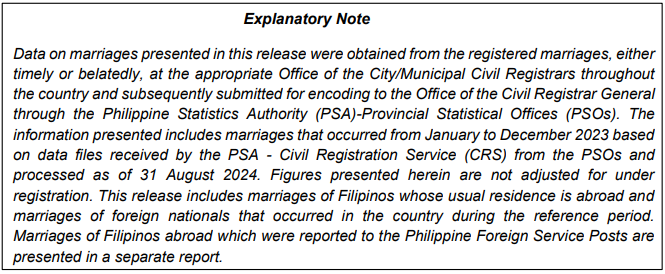
Registered marriages decreased by 0.3 percent in 2023
There were 3,261 registered marriages in 2023, representing a 6.0 percent decrease from 3,470 registered marriages in 2022. (Figure 1)
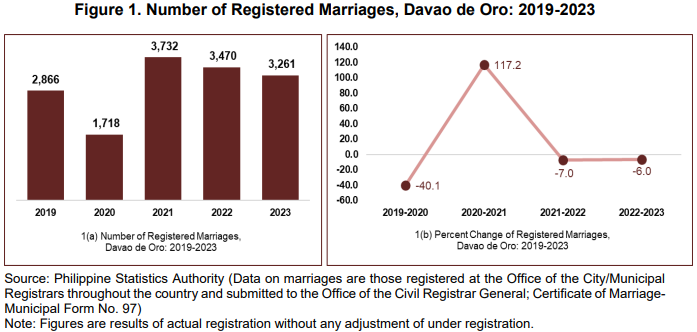
Monkayo recorded the highest number of registered marriages
Among the 11 municipalities, the highest number of registered marriages was recorded in Monkayo, with 518 total marriages, equivalent to 15.9 percent of the total. This was followed by Nabunturan with 453 marriages or 13.9 percent and Compostela with 446 marriages or 13.7 percent. On the other hand, Mawab posted the lowest number of registered marriages, with 137 marriages, contributing 4.2 percent of the total marriages in the province. (Figure 2)
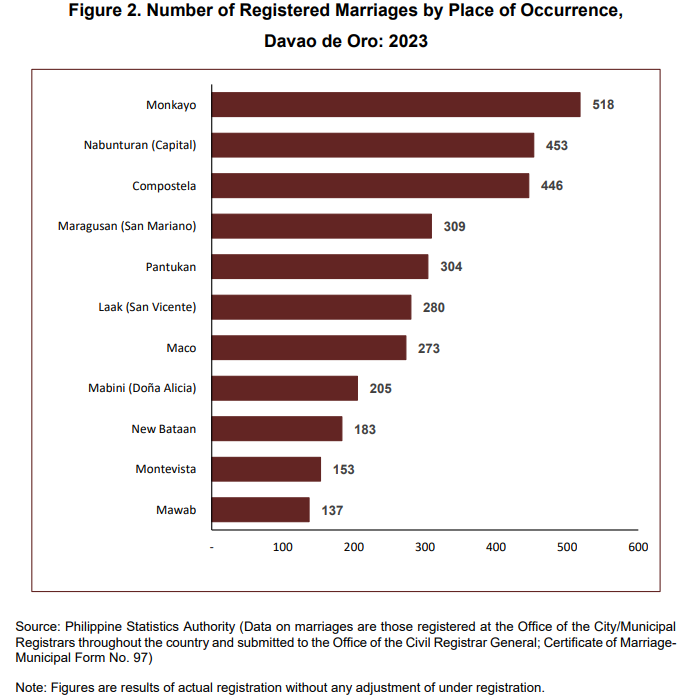
Most marriages occurred in June
In 2023, the month of June recorded the highest number of registered marriages, with 658, accounting for 20.2 percent of the total marriages in the province. This translates to a daily average of 22 marriages. February ranked second with 472 marriages (14.5 percent), followed by September with 313 marriages (9.6 percent). Meanwhile, April had the least number of registered marriages, with 129, equivalent to 4.0 percent of the total. (Figure 3)
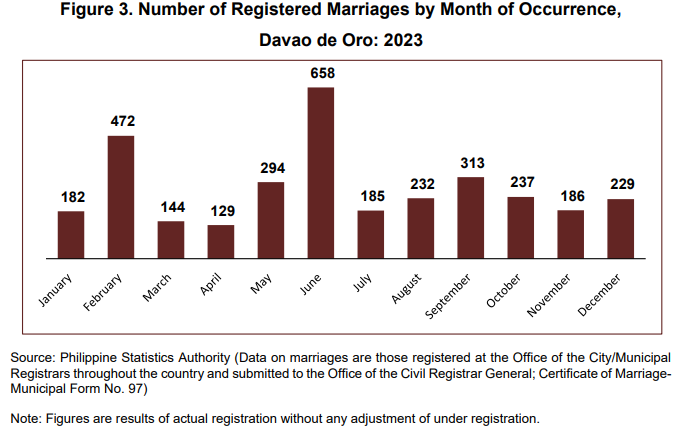
Most marriages occur in the 25-29 age group
The highest percentage of marriages occurs in the 25-29 age group, with 30.0 percent of males and 36.2 percent of females marrying at this stage. The data also shows that more females (1,181) than males (979) marry within this age group, indicating that women marry earlier than men.
The 30-34 age group follows as the second most common age for marriage, with 28.5 percent of males and 22.6 percent of females marrying at this stage. The number of males (931) is higher than females (736), indicating that while women tend to marry earlier, men are more likely to marry in their early thirties.
For early marriages, a smaller percentage of individuals marry in the 15-19 age group, with only 0.6 percent of males and 2.8 percent of females. The data shows that more females (92) than males (19) marry at this young age, highlighting that early marriage is more common among women. (Figure 4 and Table 1)
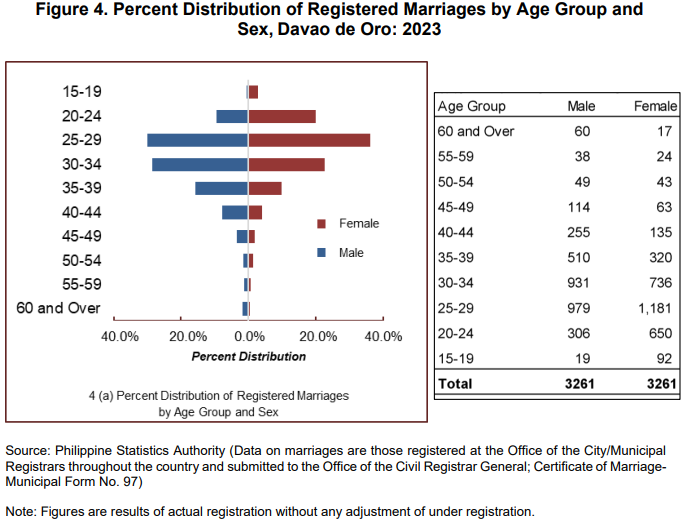
On the other hand, marriage rates decline significantly after 35 years old. Only 15.6 percent of males and 9.8 percent of females marry in the 35-39 age group. After 40, the decline continues, with only a small percentage of marriages occurring beyond this stage. By 60 years and over, the marriage rates are slight, with just 60 males and 17 females recorded. While marriage rates drop for both genders after 40, men still have a slightly higher likelihood of marrying at older ages compared to women.
Status of Registration
In terms of the status of registration in Davao de Oro, 3,205 marriages (98.3 percent) were timely registered, and only 56 (1.7 percent) marriages were registered late. This is the second-lowest late registration rate in the entire region, after Davao del Norte with 71 out of 5,349 or 1.3 percent.
Of the total registrations in Davao Region, Davao de Oro contributes 14.6 percent (3,261 out of 22,403). Among all provinces and cities in the region, Davao de Oro ranks third in total registrations.
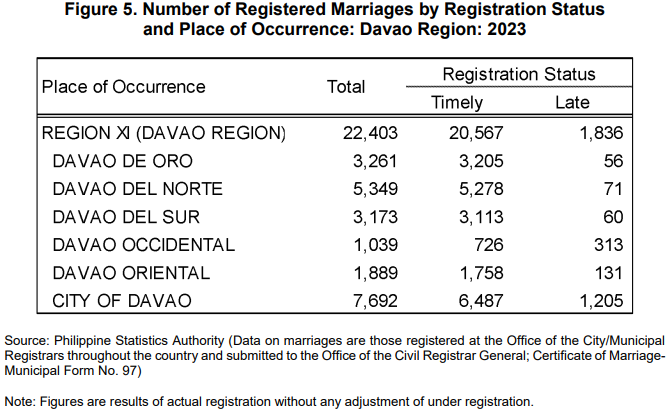
Attachments:
1. Statistical Tables
a. Table 1. Number of Registered Marriages, Davao de Oro: 2019-2023
b. Table 2. Number of Registered Marriages by Month and Place of Occurrence, Davao de Oro: 2023
c. Table 3. Number of Registered Marriages by Age Group of Male and Place of Occurrence, Davao de Oro: 2023
d. Table 4. Number of Registered Marriages by Age Group of Female and Place of Occurrence, Davao de Oro: 2023
2. Definition of Terms
VITAL STATISTICS TABLES

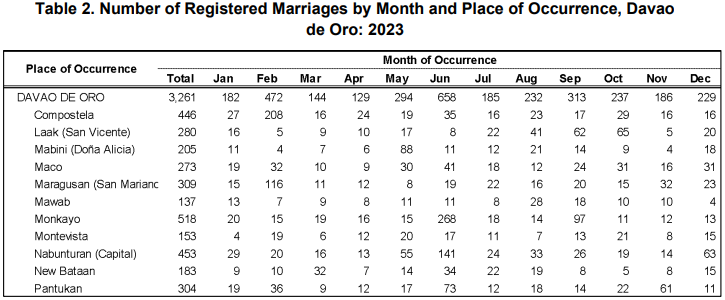
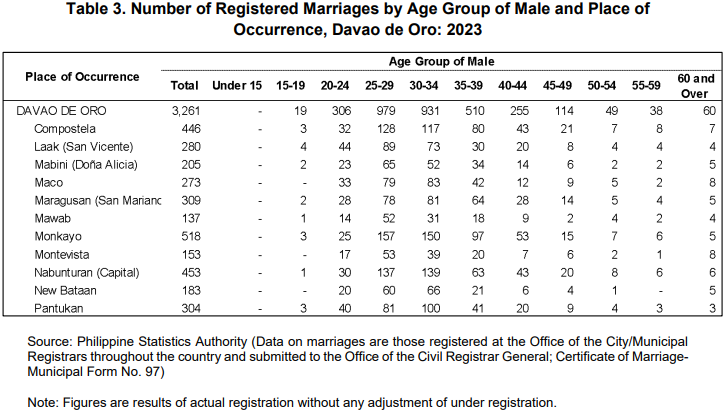
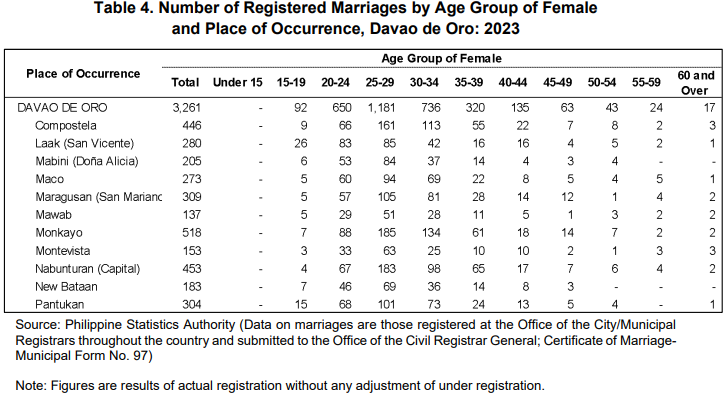
DEFINITION OF TERMS
Civil Registration is defined as the continuous, permanent and compulsory recording of the occurrences and characteristics of vital events, primarily for their value as legal documents and secondly for their usefulness as a source of statistics.
Daily Average refers to the arithmetic mean of marriage occurrences per day.
Marriage is a contract of permanent union between a man and a woman entered into in accordance with law for the establishment of conjugal and family life.
Place of Occurrence refers to the place where the vital event took place.
